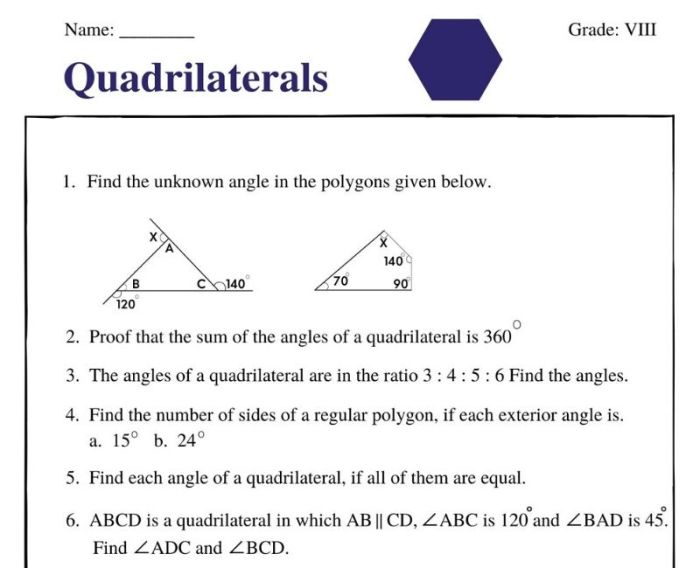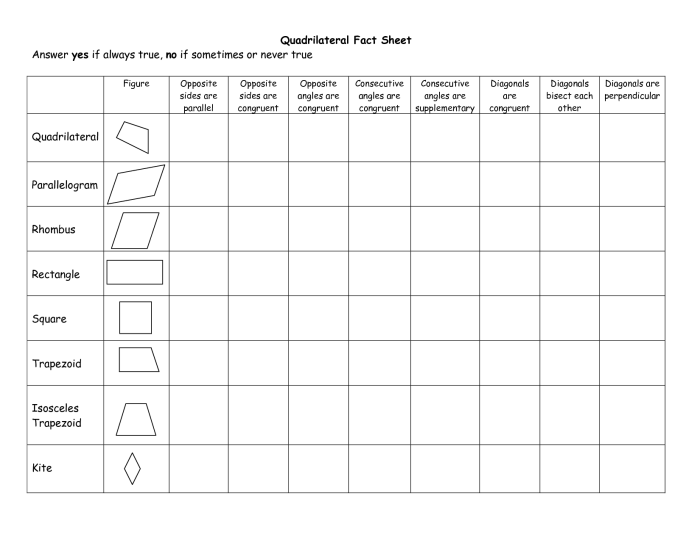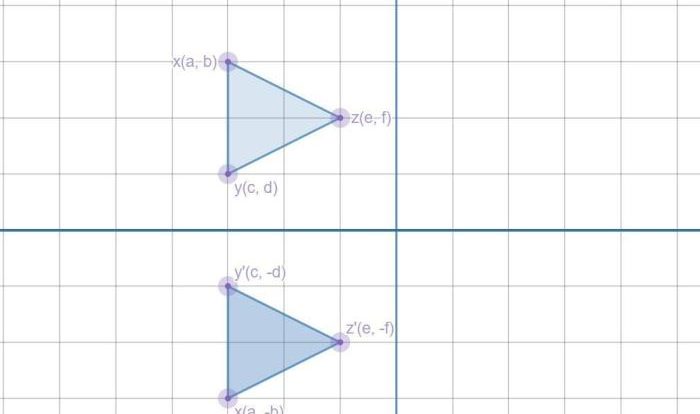Worksheet on properties of quadrilaterals – Delve into the fascinating world of quadrilaterals with our comprehensive worksheet, meticulously designed to provide a thorough understanding of their properties. This engaging resource offers a captivating overview of the different types of quadrilaterals, their defining characteristics, and their practical applications.
As you embark on this educational journey, you will uncover the secrets of these geometric shapes, unraveling their unique properties and exploring their significance in various fields.
Introduction to Quadrilaterals: Worksheet On Properties Of Quadrilaterals

A quadrilateral is a polygon with four sides. Quadrilaterals can be classified into different types based on the length of their sides and the angles between their sides.
The different types of quadrilaterals include:
- Square: A square is a quadrilateral with four equal sides and four right angles.
- Rectangle: A rectangle is a quadrilateral with four right angles and opposite sides that are equal in length.
- Parallelogram: A parallelogram is a quadrilateral with opposite sides that are parallel.
- Rhombus: A rhombus is a parallelogram with four equal sides.
- Trapezoid: A trapezoid is a quadrilateral with one pair of parallel sides.
Properties of Quadrilaterals

The properties of quadrilaterals include:
- Side lengths: The side lengths of a quadrilateral can be measured using a ruler.
- Angles: The angles of a quadrilateral can be measured using a protractor.
- Diagonals: A diagonal is a line segment that connects two opposite vertices of a quadrilateral.
- Perimeter: The perimeter of a quadrilateral is the sum of the lengths of its sides.
- Area: The area of a quadrilateral is the amount of space that it covers.
Theorems Related to Quadrilaterals

There are a number of theorems that relate to quadrilaterals. These theorems include:
- The Pythagorean Theorem: The Pythagorean Theorem states that in a right triangle, the square of the length of the hypotenuse is equal to the sum of the squares of the lengths of the other two sides.
- The Parallelogram Law: The Parallelogram Law states that the area of a parallelogram is equal to the product of its base and height.
- The Trapezoid Rule: The Trapezoid Rule states that the area of a trapezoid is equal to the product of its height and the average of its bases.
Applications of Quadrilaterals
Quadrilaterals are used in a variety of applications, including:
- Architecture: Quadrilaterals are used in the construction of buildings, bridges, and other structures.
- Engineering: Quadrilaterals are used in the design of machines, vehicles, and other products.
- Design: Quadrilaterals are used in the creation of art, logos, and other visual designs.
Commonly Asked Questions
What is the purpose of the worksheet on properties of quadrilaterals?
The worksheet aims to provide a comprehensive understanding of the properties of quadrilaterals, including their types, characteristics, and applications.
What types of problems can be found in the worksheet?
The worksheet features a variety of problems that cover different aspects of quadrilaterals, such as identifying types, measuring properties, and applying theorems.
How can the worksheet be used to assess student understanding?
The worksheet can be used as a formative assessment tool to evaluate students’ knowledge and understanding of the properties of quadrilaterals.

